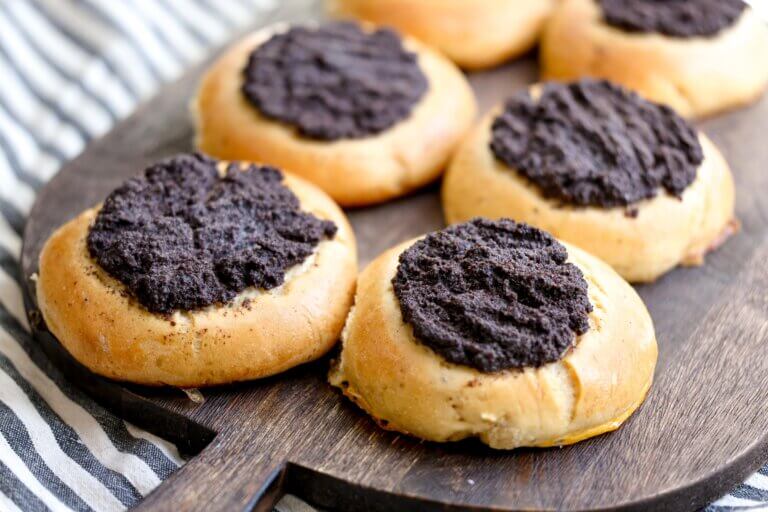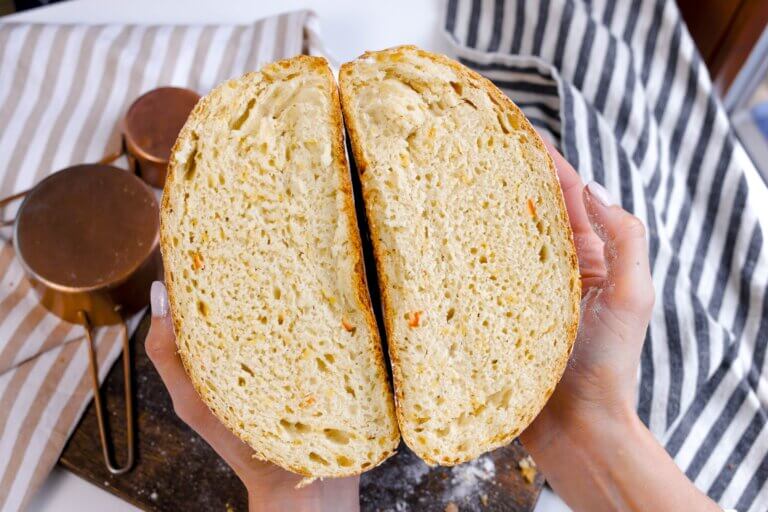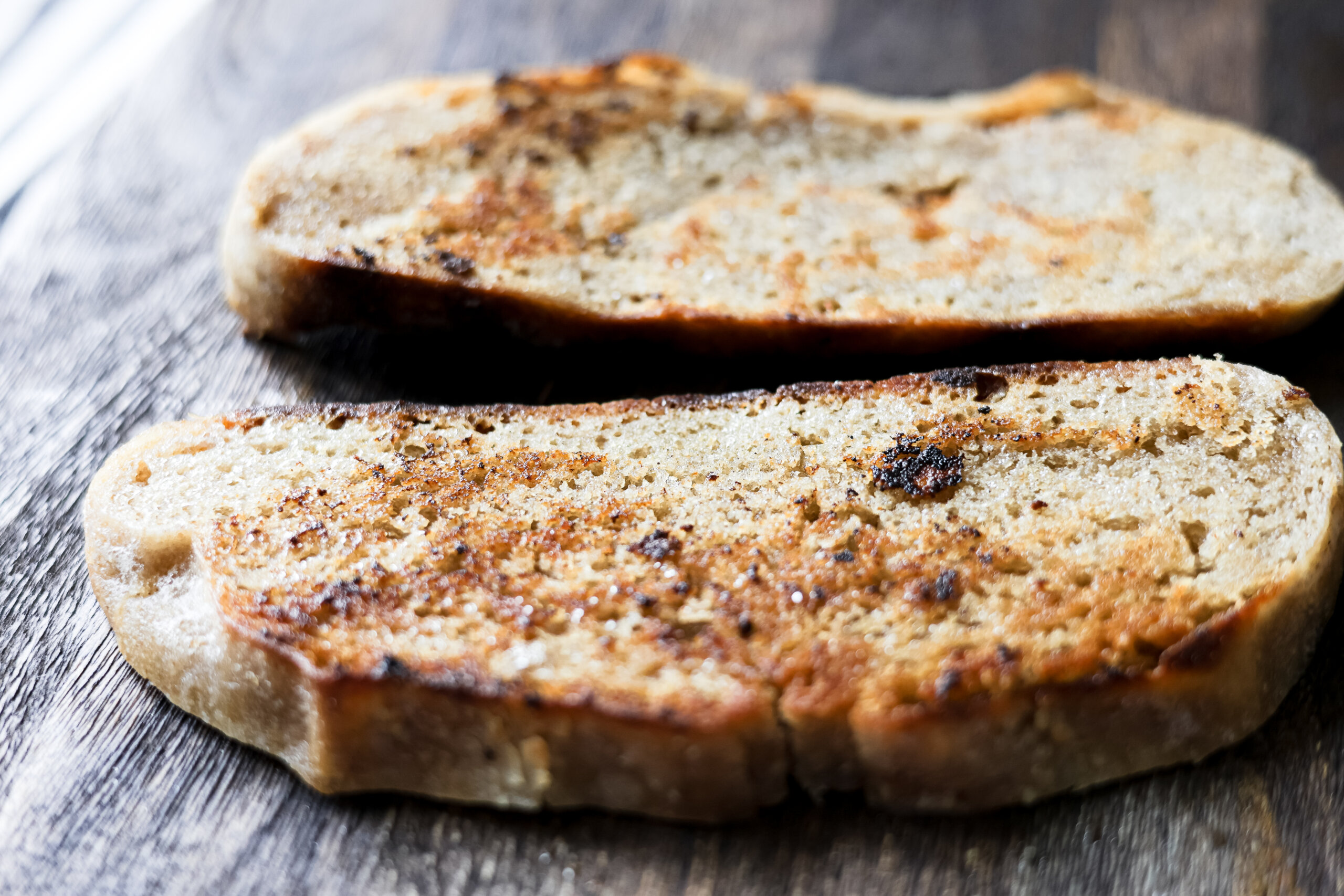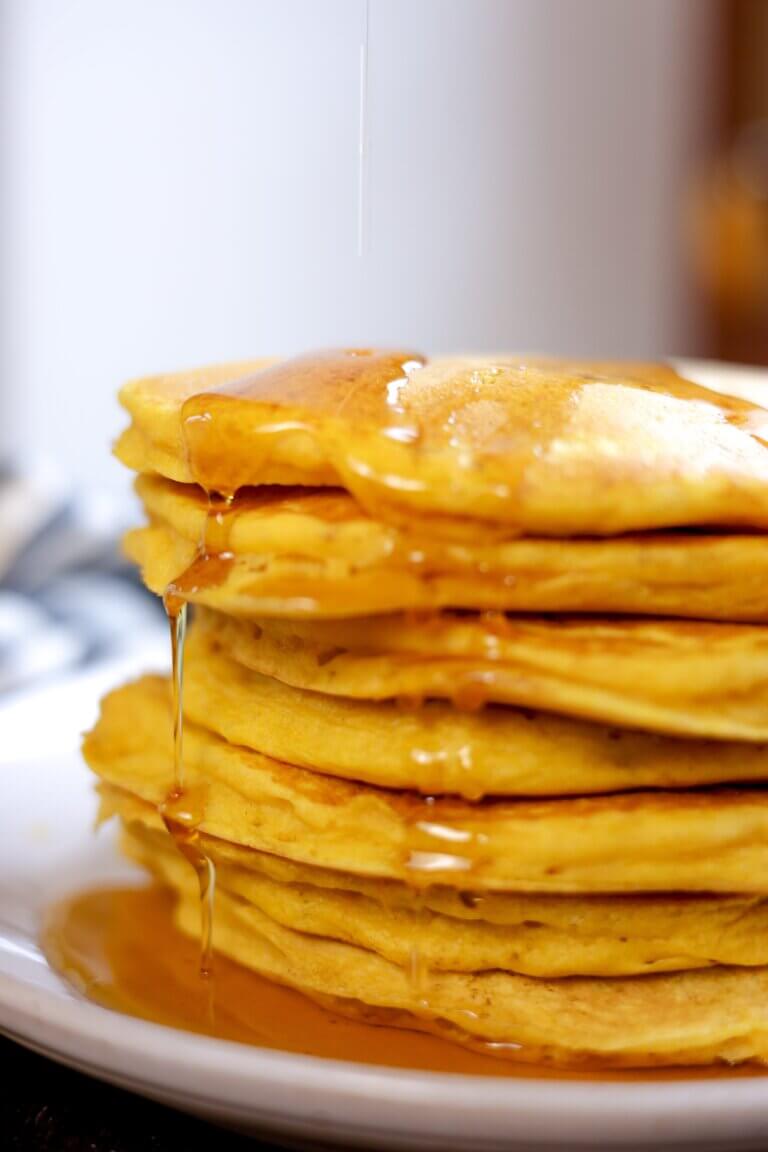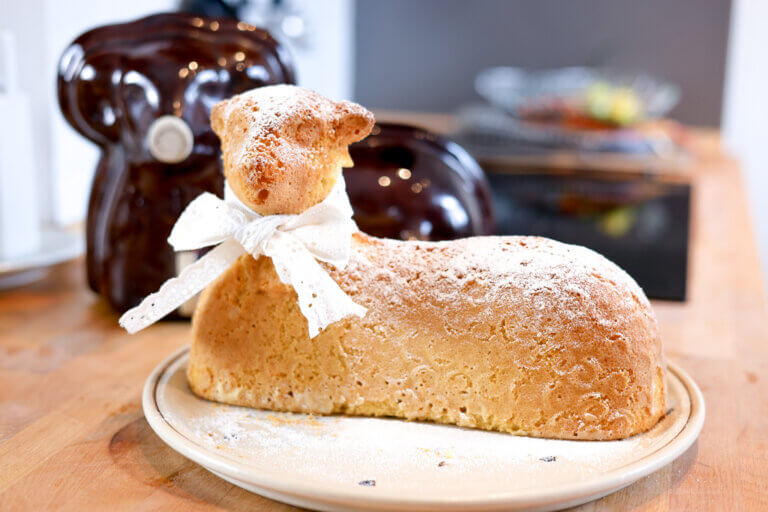Czech Sweet Easter Bread “Mazanec” {Traditional Recipe}
This traditional Czech Sweet Easter bread recipe is easy to make and delicious to enjoy!

Easter is one of my favorite times of year. It marks the onset of spring, but it also brings with it a host of Czech traditions predating Christianity that I grew up celebrating, as well as traditional Czech Easter food. This is the first year in many years that I get to spend this time of the year in Central Europe again, and I’m so excited to introduce my husband and the boys to all the traditional dishes and practices I grew up loving.
One of my favorite things to enjoy during Easter in the Czech Republic, and make with my mom has always been Czech sweet easter bread “Mazanec”. A soft, round loaf of sweet bread that we would eat for breakfast with a layer of butter, or as a snack throughout the day. Growing up, we always made this recipe using conventional yeast. But ever since I learned how to make sourdough, I can’t hardly stand the taste of quick rise yeasts anymore. And so I decided to challenge myself and attempt a sourdough mazanec by altering the original recipe my mom used and substituting active dry yeast with my sourdough starter. And it worked wonderfully! My mazanec loaf tuned out airy & soft and simply delicious.

This article may contain affiliate links, which means I make a small commission at no extra cost to you. As an Amazon Associate, I earn from qualifying purchases at no extra cost to you. You can read the full disclosure policy.
Why You’ll Love This Recipe
- This recipe is very easy to make. Especially if you’ve got experience with sourdough bread recipes, this Czech sweet easter bread won’t be a challenge at all
- The taste of this bread is delicious. It’s slightly sweet, but not too much. Such a fun variation of the traditional sourdough bread taste.
- Sourdough adds a distinct tangy flavor and complexity to the bread that can’t be replicated with commercial yeast. The sourdough fermentation process also contributes to a unique texture, with a slightly chewy crust and a moist crumb.
- Serve it alongside a festive Lamb Cake for a touch of sweetness, and a hearty Easter Stuffing to balance out your Easter spread. Together, they make a beautiful trio for your holiday table!
Tools

Instructions
Mix Ingredients
- Add all the ingredients to your Kitchenaid mixer bowl of your standing mixer. With the dough hook attachment on, knead together for 5-10 minutes.
Rise & Shape
- Transfer to an oiled bowl, cover with a clean kitchen towel, and allow the dough to rise in warm spot for around 2 – 4 hours.
- After dough has roughly doubled, take out, and shape into a round loaf by folding the edges over into the middle and gently twisting the loaf towards yourself.
- Place onto a piece of parchment paper, and transfer into a banneton basket or large bowl, cover with a plastic sack or plastic wrap, and place in the fridge overnight.
Second Rise & Prep for Baking
- In the morning, allow to rise for a few more hours until the loaf reaches your desired size.
- Whisk a whole egg to create an egg wash, and brush on the top of your loaf. Using a sharp razor or scoring knife, score a small shallow cross shape into the very center of your loaf. Sprinkle the top of pieces of almonds.
- Pickup by the corners of the parchment paper and transfer the whole thing onto a baking sheet.
Bake
- Preheat oven to 200 degrees Celsius. Place your baking sheet onto the center oven rack and immediately turn temperature down to 180 degrees celsius.
- Bake for 30-35 minutes until lightly golden brown.
- Serve with a light sprinkling of confectioners sugar or lather with butter.
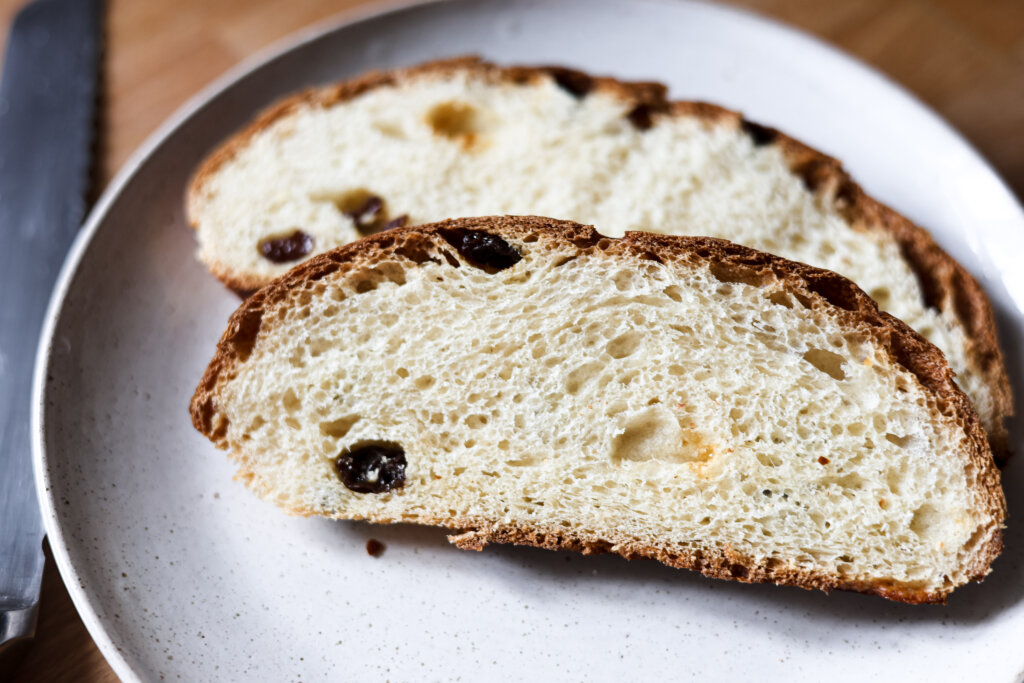
FAQ

Tips
- Active Sourdough Starter: Ensure your sourdough starter is active and bubbly before using it in your Mazanec dough.
- Maintain Proper Hydration: Pay attention to the hydration level of your dough. Sourdough Mazanec dough should be soft and slightly sticky but still manageable. Adjust the amount of flour or water as needed to achieve the right consistency.
- Patience with Proofing: Sourdough Mazanec requires longer proofing times compared to bread made with commercial yeast. Allow the dough to ferment and rise at a controlled room temperature until it has doubled in size. This may take several hours or even overnight, depending on the temperature and activity of your starter.
- Enhance Flavor with Long Fermentation: For a more complex flavor, consider doing a long, slow fermentation by allowing the dough to rise in the refrigerator overnight. This extended fermentation period develops the flavors and improves the texture of the bread.
- Add Flavors and Mix-Ins: Customize your Mazanec by adding flavors like lemon zest, vanilla extract, or spices such as cinnamon and nutmeg. You can also incorporate mix-ins like dried fruits, nuts, or chocolate chips for added texture and flavor.
- Shape with Care: After the dough has finished proofing, handle it gently when shaping to preserve the air bubbles created during fermentation. Shape the dough into a loaf or braid for a traditional Mazanec presentation.
- Score the Dough: Before baking, score the top of the Mazanec dough with a sharp knife or razor blade to allow for expansion during baking and to create an attractive pattern on the surface of the bread.
- Cool Properly: Allow the baked Mazanec to cool completely on a wire rack before slicing. This helps to set the crumb and prevents the bread from becoming gummy.

Storage
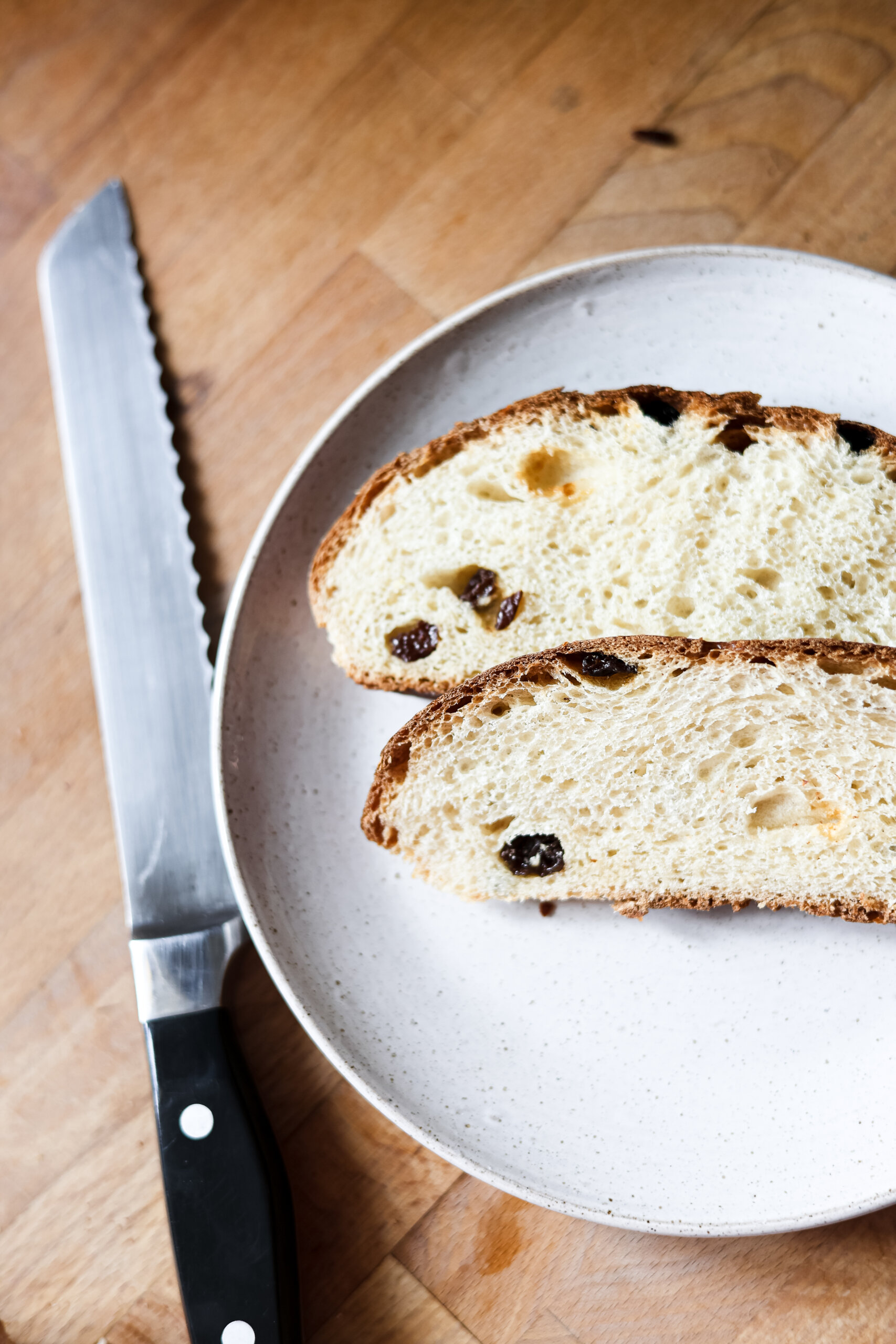
Czech Sweet Easter Bread “Mazanec”
Ingredients
- 1 egg
- 50 g water
- 80 g softened butter
- 80 g sugar
- 290 g all purpose flour
- 100 g active sourdough starter ??
- 1 tsp vanilla extract
- 1/4 tsp salt
- lemon peel
- handful of golden raisins
Instructions
1. Mix Ingredients
- Add all the ingredients to your Kitchenaid mixer bowl of your standing mixer. With the dough hook attachment on, knead together for 5-10 minutes.
2. Rise & Shape
- Transfer to an oiled bowl, cover with a clean kitchen towel, and allow the dough to rise in warm spot for around 2 – 4 hours.
- After dough has roughly doubled, take out, and shape into a round loaf by folding the edges over into the middle and gently twisting the loaf towards yourself.
- Place onto a piece of parchment paper, and transfer into a banneton basket or large bowl, cover with a plastic sack or plastic wrap, and place in the fridge overnight.
3. Second Rise & Prep for Baking
- In the morning, allow to rise for a few more hours until the loaf reaches your desired size.
- Whisk a whole egg to create an egg wash, and brush on the top of your loaf. Using a sharp razor or scoring knife, score a small shallow cross shape into the very center of your loaf. Sprinkle the top of pieces of almonds.
- Pickup by the corners of the parchment paper and transfer the whole thing onto a baking sheet.
4. Bake
- Preheat oven to 200 degrees Celsius. Place your baking sheet onto the center oven rack and immediately turn temperature down to 180 degrees celsius.
- Bake for 30-35 minutes until lightly golden brown.
- Serve with a light sprinkling of confectioners sugar or lather with butter.
Video
Notes
Tips
- Active Sourdough Starter: Ensure your sourdough starter is active and bubbly before using it in your Mazanec dough. A healthy starter will help leaven the bread properly and contribute to its flavor.
- Maintain Proper Hydration: Pay attention to the hydration level of your dough. Sourdough Mazanec dough should be soft and slightly sticky but still manageable. Adjust the amount of flour or water as needed to achieve the right consistency.
- Patience with Proofing: Sourdough Mazanec requires longer proofing times compared to bread made with commercial yeast. Allow the dough to ferment and rise at a controlled room temperature until it has doubled in size. This may take several hours or even overnight, depending on the temperature and activity of your starter.
- Enhance Flavor with Long Fermentation: For a more complex flavor, consider doing a long, slow fermentation by allowing the dough to rise in the refrigerator overnight. This extended fermentation period develops the flavors and improves the texture of the bread.
- Incorporate Enriching Ingredients: Traditional Mazanec is enriched with ingredients like eggs, butter, and sometimes milk or cream. These additions contribute to a tender crumb and rich flavor. Be sure to use quality ingredients for the best results.
- Add Flavors and Mix-Ins: Customize your Mazanec by adding flavors like lemon zest, vanilla extract, or spices such as cinnamon and nutmeg. You can also incorporate mix-ins like dried fruits, nuts, or chocolate chips for added texture and flavor.
- Shape with Care: After the dough has finished proofing, handle it gently when shaping to preserve the air bubbles created during fermentation. Shape the dough into a loaf or braid for a traditional Mazanec presentation.
- Score the Dough: Before baking, score the top of the Mazanec dough with a sharp knife or razor blade to allow for expansion during baking and to create an attractive pattern on the surface of the bread.
- Bake with Steam: Create steam in the oven during the first part of the baking process to help develop a crisp crust and promote oven spring. You can achieve this by placing a pan of boiling water in the oven or by spritzing the oven walls with water.
- Cool Properly: Allow the baked Mazanec to cool completely on a wire rack before slicing. This helps to set the crumb and prevents the bread from becoming gummy.
Storage
- Wrap or Seal: Once cooled, wrap the Mazanec tightly in plastic wrap or aluminum foil to protect it from air exposure. Alternatively, you can store it in an airtight container.
- Room Temperature: If you plan to consume the Mazanec within 2-3 days, you can store it at room temperature. Keep it in a cool, dry place away from direct sunlight and heat sources.
- Refrigeration: If you want to extend the shelf life of the Mazanec, you can store it in the refrigerator. Place it in an airtight container or wrap it tightly to prevent it from drying out. Keep in mind that refrigeration may cause the bread to stale faster, so it's best to consume it within 5-7 days.
- Freezing: Sourdough Mazanec freezes well and can be stored in the freezer for longer-term storage. Wrap the cooled Mazanec tightly in plastic wrap or aluminum foil, then place it in a freezer-safe bag or container to prevent freezer burn. Label the container with the date to keep track of its freshness.
- Thawing: When you're ready to enjoy the frozen Mazanec, remove it from the freezer and let it thaw at room temperature for a few hours or overnight. You can also reheat slices of Mazanec in a toaster or warm them in the oven for a few minutes until heated through.
- Slice as Needed: To minimize exposure to air and help maintain freshness, slice the Mazanec as needed rather than slicing the entire loaf at once.
This article may contain affiliate links, which means I make a small commission at no extra cost to you. As an Amazon Associate, I earn from qualifying purchases at no extra cost to you. You can read the full disclosure policy.

